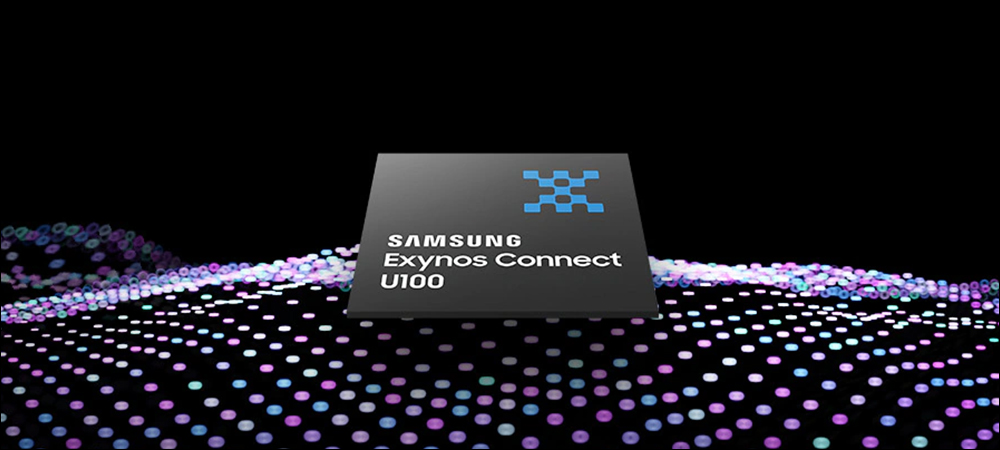RFID Journal LIVE! 2023 will feature end-user companies discussing RFID’s use in various industries, as well as exhibitors offering tagging solutions for multiple applications. To learn more, visit the event’s website.
Global electronics company Samsung has released an ultra-wideband (UWB) chip for use in smartphones and other devices to identify and locate individuals and items within a device’s vicinity. The technology, used in Internet of Things (IoT) applications, is intended to interact with tags, badges, key fobs or other devices within 10 centimeters (3.9 inches) or less. The Exynos Connect brand combines Bluetooth, Wi-Fi and UWB, with the U100 model the first product in that family to include UWB.
The company says its chip can be built into IoT devices that include phones, tablets and cars, enabling them to transfer data at high speeds. The Exynos Connect U100 chip is designed to provide location accuracy at less than 5 degrees of angle, so that a system leveraging the chip can identify where a UWB-tagged item or person is, as well as the direction in which they are moving and how fast, and ultimately enable an action based on that data.

The Exynos Connect U100 chip
Companies using the chips are likely to be automotive manufacturers, or product and solution providers that make digital keys, location trackers, or devices used for mobile payments, and to enable smart-home and smart-factory deployments, according to Sangdae Lee, the product manager of Samsung Electronics’ Mobile SOC Marketing Group. The company’s Exynos processor products are built for mobility, Samsung reports, and can be used as a wearable or automotive device.
How the System Works
If a device has the U100 chip built in, it will transmit a UWB signal in the form of a 2-nanosecond pulse, which is then received by tags or devices that respond with their own unique ID number. The chip can communicate with any UWB-based product, and the solution uses time-of-flight (ToF) measurements between the two UWB devices. That ToF value is calculated by measuring the times of challenge and response. UWB employs a 500 MHz channel bandwidth, and the data collection is near-real-time.

Sangdae Lee
Once an item with the Samsung chip begins transmitting a signal, it continues to seek a response from another UWB device. For instance, if an individual has the UWB chip built into their phone, it can interact with other objects, such as the phone user’s car-locking system. The vehicle would unlock only if the phone was identified at a very precise location, such as within a meter of the car door.
The system could provide access control at an office or residential building, Samsung indicates. In such a scenario, users could opt into a system by which their phones would be recognized by the U100 chip built into the door to a secure area. If an individual’s unique ID that responded to the chip’s interrogation was recognized as authorized, the door would then open when that person was within close range of that door.
Another use case Samsung cites is in home entertainment. In that case, the chip in a smart television could interact with a home resident’s phone if it also had UWB functionality. If individuals were watching a video or program on their phone, and if they came within range of the monitor, the chip would identify them, determine that they were approaching the television, and then transfer that content to display on the TV and on their phones.
Consolidating Wireless Technologies
The Exynos Connect family of products is designed to leverage Samsung’s existing technologies, Lee says, by consolidating short-range wireless communication solutions, “such as Wi-Fi, Bluetooth and UWB that are essential in enabling an increasingly hyper-connected world.” He adds, “Our goal is to help people or devices to always stay connected to the Internet or with each other. UWB, in particular, will be exceptionally useful when determining relative positions and measuring precise distances.”
The UWB-based product is still in its initial adoption stages, Lee reports, and is gradually making its way into mobile and automotive solutions. Numerous Samsung handsets, for example, now come with UWB functionality built in. “We’re initially focusing on mobile handsets,” he says, “as it represents one of the largest markets for UWB commercialization.” Additionally, the company is exploring the automotive market, which is seeing strong demands from customers.
The chips come with flash memory and power management, and are designed to be powered by a coin-cell battery. However, Lee notes, the Exynos Connect U100 supports a wide input voltage range and multiple RF combinations, allowing customers to choose from a variety of power sources at different prices. That power flexibility will enable the IC to be used for mobile, automotive or IoT solutions, he explains.
To ensure security, the chip’s scrambled timestamp function and encryption engine are designed to prevent hackers. With this security feature, Lee says, the Exynos Connect U100 can protect digital car keys from being hacked. That encryption, he adds, can help to prevent what have become common security breaches for vehicle access, which has been accomplished in the past through the hacking of communication signals.
The chip has been certified by the FiRa Consortium, a standards organization that tests UWB devices for interoperability. Samsung is now in discussions with several customers in the mobile and automotive spaces, though it has declined to provide details regarding potential deployments. “The flexibility of the RF signal paths,” Lee states, “makes the U100 especially well-suited for a range of applications.”
Key Takeaways:
- A new UWB processor from Samsung will enable precise location-based data transfer between mobile devices.
- Companies that sell mobile devices, as well as automotive manufacturers, are among those planning adoptions of a system to identify where an individual or object is located, within less than 10 centimeters.

